

高等学校化学学报 ›› 2020, Vol. 41 ›› Issue (11): 2306.doi: 10.7503/cjcu20200408
• 庆祝《高等学校化学学报》复刊40周年专栏 • 上一篇 下一篇
张怡萌,张慧欣,刘洋
收稿日期:2020-06-30
出版日期:2020-11-10
发布日期:2020-11-06
基金资助:
ZHANG Yimeng1, ZHANG Huixin1,2, LIU Yang1( )
)
Received:2020-06-30
Online:2020-11-10
Published:2020-11-06
Contact:
LIU Yang
E-mail:liu-yang@mail.tsinghua.edu.cn
Supported by:摘要:
外泌体是具有各种关键生物活性分子(如脂质、 蛋白质和核酸)的细胞外囊泡. 它们可以由所有类型的细胞分泌, 并分布在所有生物流体中, 如血液、 唾液、 汗水和尿液等. 更重要的是, 外泌体可以参与多种生理活动, 包括细胞间通讯、 哺乳动物的繁殖和免疫反应, 并在新陈代谢以及心血管疾病、 神经变性和癌症等疾病的病理进展中起重要作用, 这使其成为备受关注的天然非侵入性生物标记物, 并且被认为是可用于临床诊断和治疗的潜在工具。本文综述了用于检测外泌体的生物传感器的最新发展, 包括荧光、 电化学、 电化学发光、 表面增强拉曼光谱、 比色法和微流控技术等分析方法; 总结了在临床诊断和疾病治疗中外泌体的临床应用; 还讨论了外泌体检测所面临的挑战以及外泌体在临床诊断和疾病治疗等方面的应用潜力.
中图分类号:
TrendMD:
张怡萌, 张慧欣, 刘洋. 外泌体生物分析及其临床应用研究进展. 高等学校化学学报, 2020, 41(11): 2306.
ZHANG Yimeng, ZHANG Huixin, LIU Yang. Recent Advances of Exosomes Bioanalysis and Their Clinic Applications. Chem. J. Chinese Universities, 2020, 41(11): 2306.

Fig.1 TEM image of exosomes derived by HeLa cells[4](A) and exosomal structure[2](B)(A) Copyright 2019, American Chemical Society; (B) Copyright 2019, Wiley.
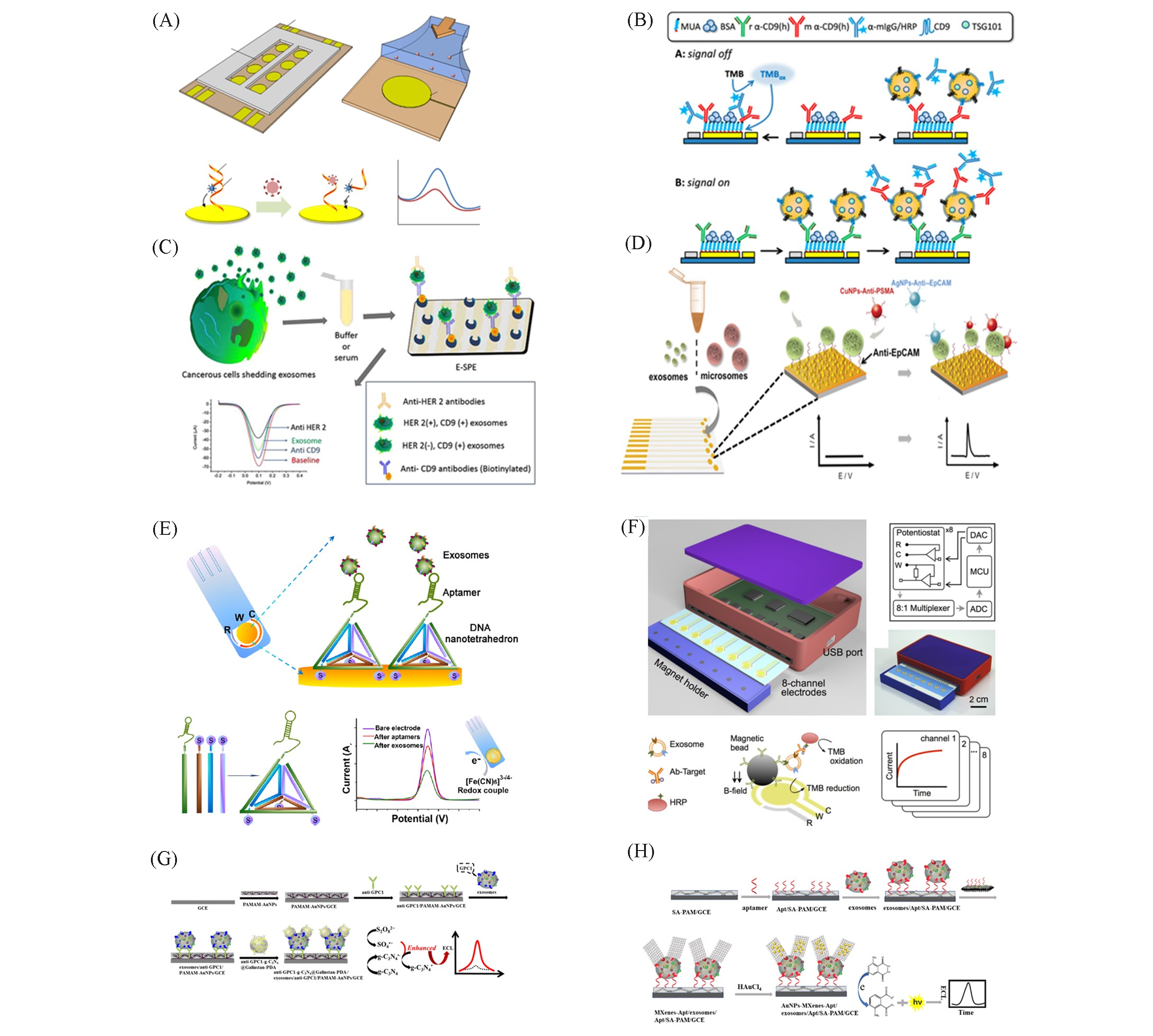
Fig.3 Scheme of an Au electrode array patterned on a glass surface for detection of exosomes[45](A), scheme of the electrochemical sensor using CD9 antibody for detection of exosomes[46](B), scheme of the electrochemical sensor using CD9 antibody for detection of exosomes in cell culture media[47](C), scheme of the multiplexed electrochemical sensor for detection of exosomes[48](D), scheme of the electrochemical sensor for detection of exosomes based on the gold electrodes[36](E), scheme of the iMEX for detection of exosomes[41](F), ECL biosensor for detection of HeLa cell derived exosomes[4](G), ECL biosensor for detection of OVCAR cell derived exosomes[53](H)(A) Copyright 2016, Elsevier; (B) Copyright 2016, American Chemical Society;(C) Copyright 2017, Wiley; (D) Copyright 2016, Wiley; (E) Copyright 2017, American Chemical Society; (F) Copyright 2016, American Chemical Society; (G) Copyright 2019, American Chemical Society; (H) Copyright 2020, American Chemical Society.
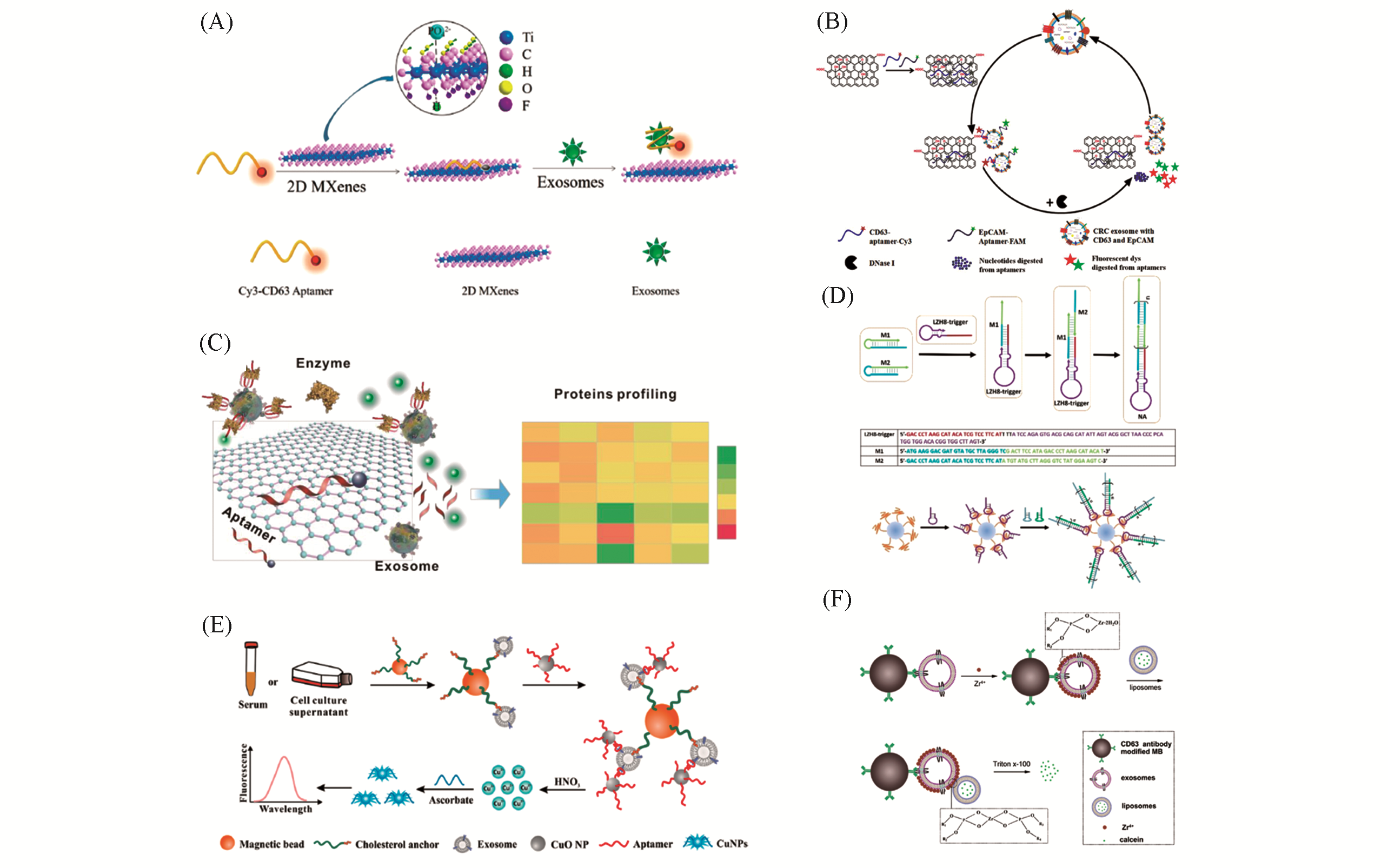
Fig.4 Scheme of the fluorescent biosensor based on the Cy3?CD63 aptamer/Ti3C2 MXenes nanocomplex as nanoprobe to detect exosomes[63](A), scheme of the fluorescent biosensor based on the fluorophore? labeled aptamers[64](B), scheme of the fluorescent ExoAPP[65](C), scheme of the fluorescent biosensor based on the aptamer/DNA nanoassemblies on the surfaces of exosomes[66](D), scheme of fluorescent biosensor based on a copper?mediated signal amplification strategy[67](E), scheme of fluorescent biosensor based on zirconium?phosphate coordination[68](F)(A) Copyright 2018, American Chemical Society; (B) Copyright 2018, Elsevier; (C) Copyright 2018, American Chemical Society; (D) Copyright 2017, American Chemical Society; (E) Copyright 2018, American Chemical Society; (F) Copyright 2019, Royal Society of Chemistry.
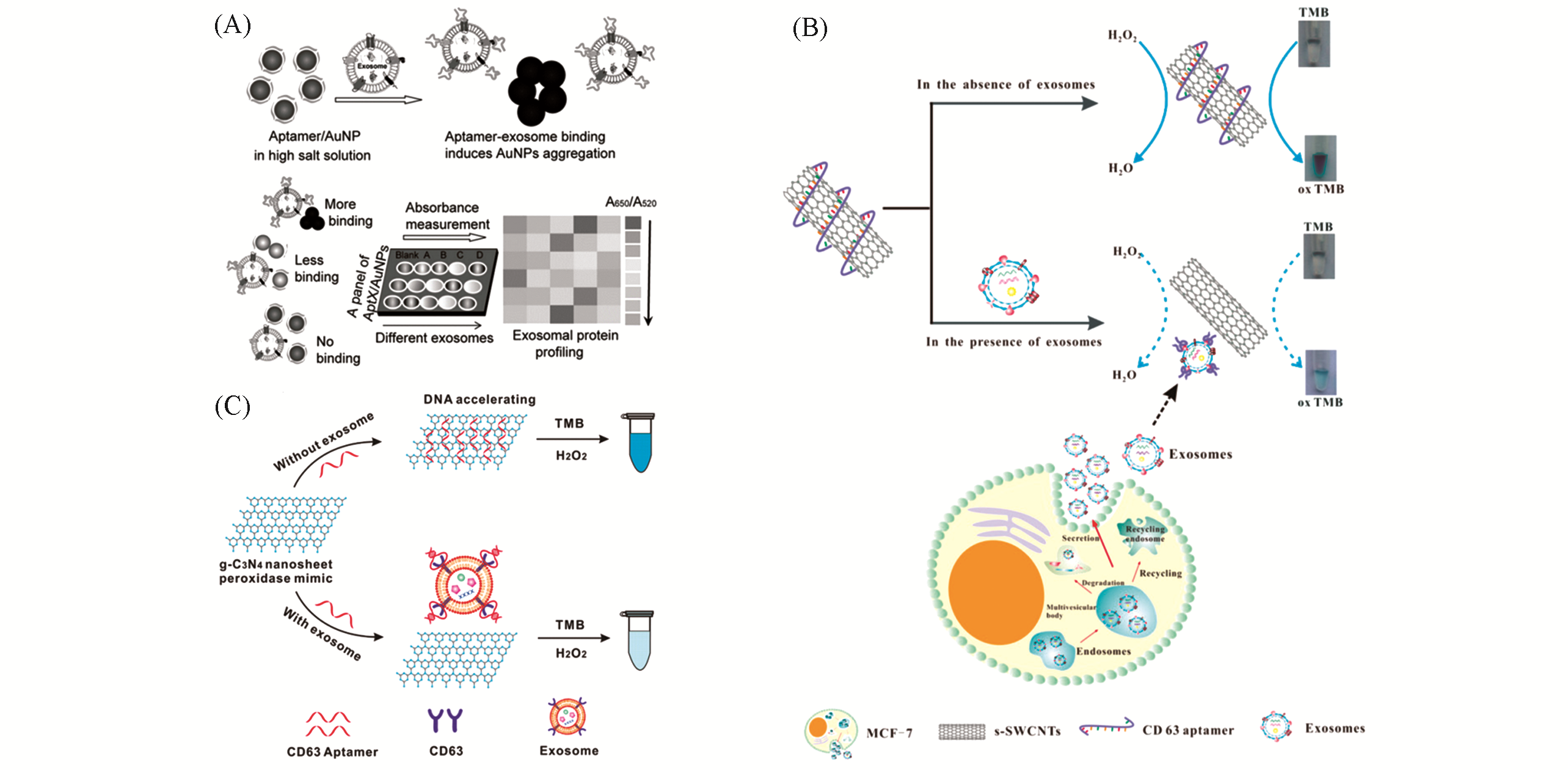
Fig.5 Scheme of the colorimetric biosensor based on the aptamer/AuNPs complex for molecular profi?ling of exosomal proteins[72](A), (B)scheme of the colorimetric biosensor based on DNA?capped single?walled carbon nanotubes[71], scheme of the colorimetric biosensor based on g?C3N4 NSs[73](C)(A) Copyright 2017, Wiley; (B) Copyright 2017, Elsevier; (C) Copyright 2017, American Chemical Society.
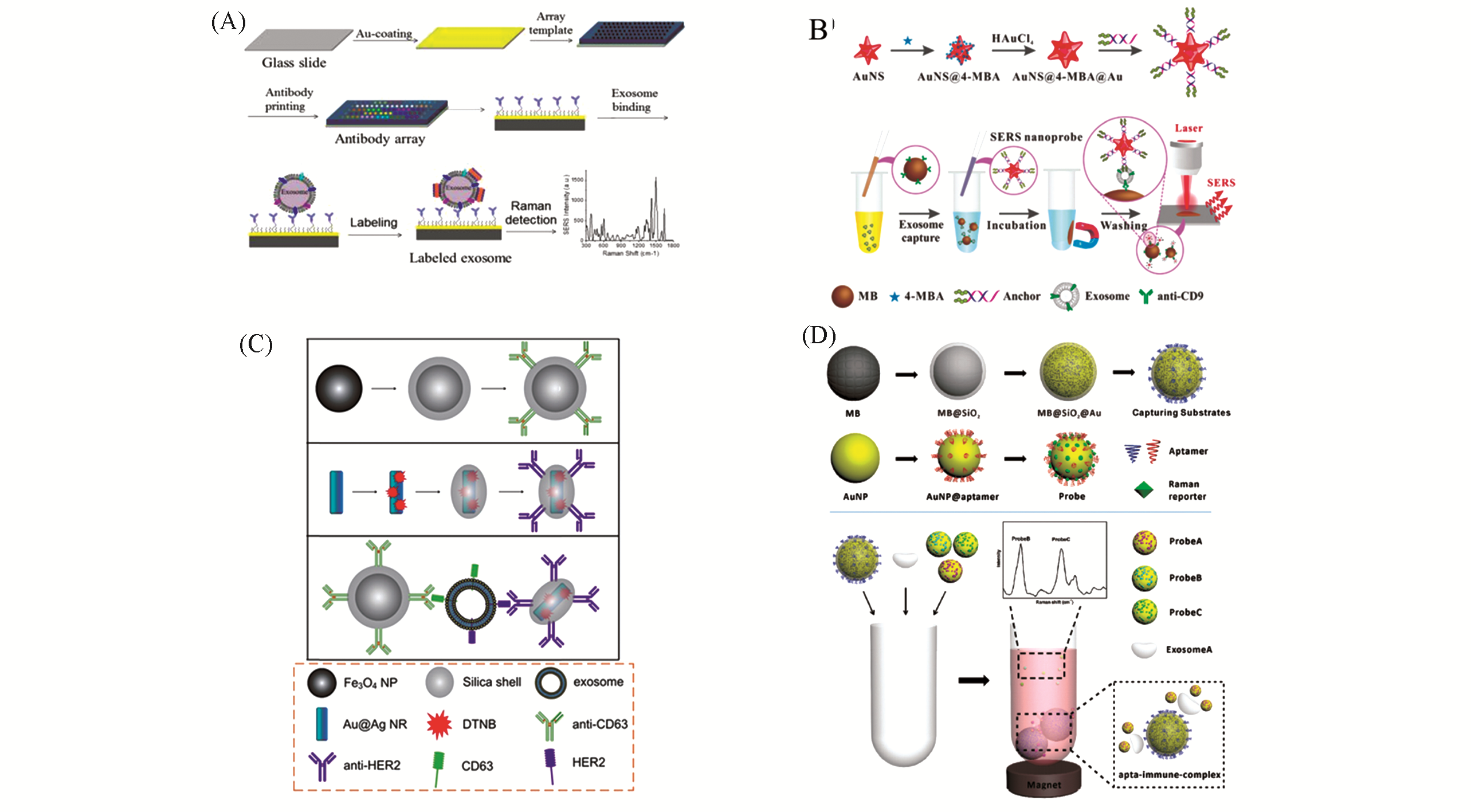
Fig.6 Scheme of the solid?based SERS biosensors based on the gold nanorods coated with QSY21 Raman reporters[78](A); scheme of the solid?based SERS biosensors based on AuNS@4?MBA@Au[79](B); scheme of the solution?based SERS biosensors based on the nanobeads with anti?HER2 antibody[80](C); scheme of the solution?based SERS biosensors based on the gold shell magnetic nanobeads with aptamers[81](D)(A) Copyright 2018, Ivyspring International Publisher; (B) Copyright 2018, The Royal Society of Chemistry; (C) Copyright 2016, The Royal Society of Chemistry; (D) Copyright 2018, The Royal Society of Chemistry.
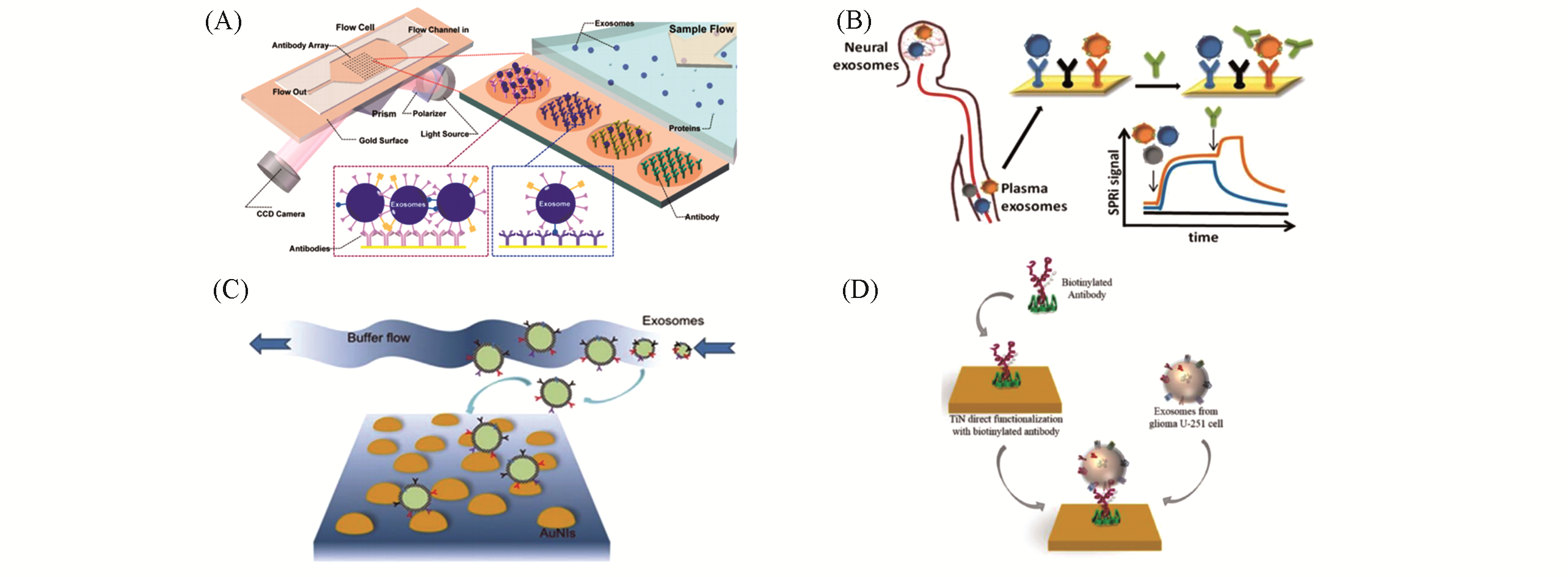
Fig.7 Scheme of the SPRi biosensor on the gilded gold chip[86](A), scheme of the SPRi biosensor based on the CD81 and GM1 antibodies[87](B), scheme of the LSPR based on the SAM?AuNIs[88](C), scheme of the SPR biosensor based on the TiN[89](D)(A) Copyright 2014, American Chemical Society; (B) Copyright 2018, American Chemical Society; (C) Copyright 2017, Elsevier; (D) Copyright 2019, Wiley.
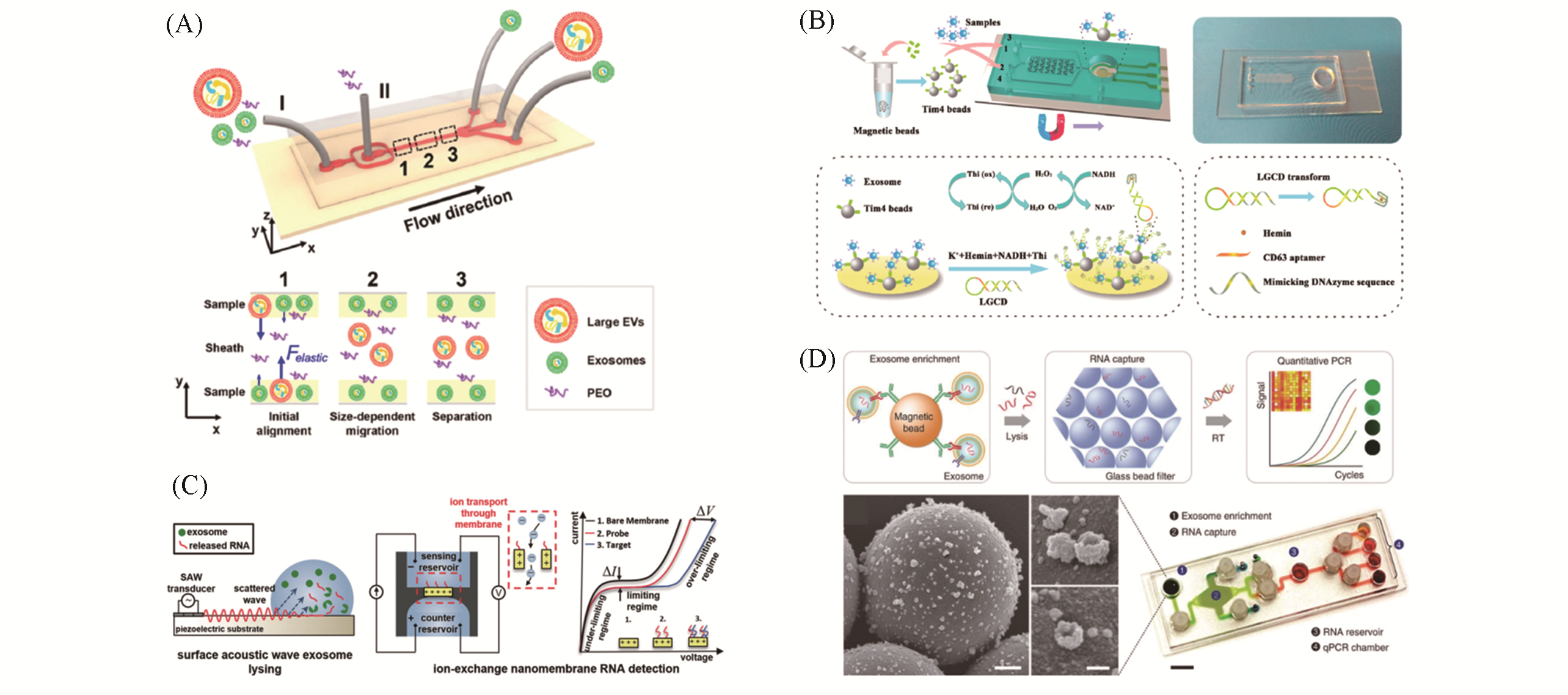
Fig.8 Scheme of the microfluidic biosensors for isolation of the exosomes[92](A); scheme of the ExoPCD?chip for the isolation and in situ detection of the exosomes[93](B); scheme of the microfluidic chip with SAW for exosomal RNA[94](C); scheme of the microfluidic chip for POC[95](D)(A) Copyright 2017, American Chemical Society; (B) Copyright 2018, American Chemical Society; (C) Copyright 2015, The Royal Society of Chemistry; (D) Copyright 2015, Nature Publishing Group.
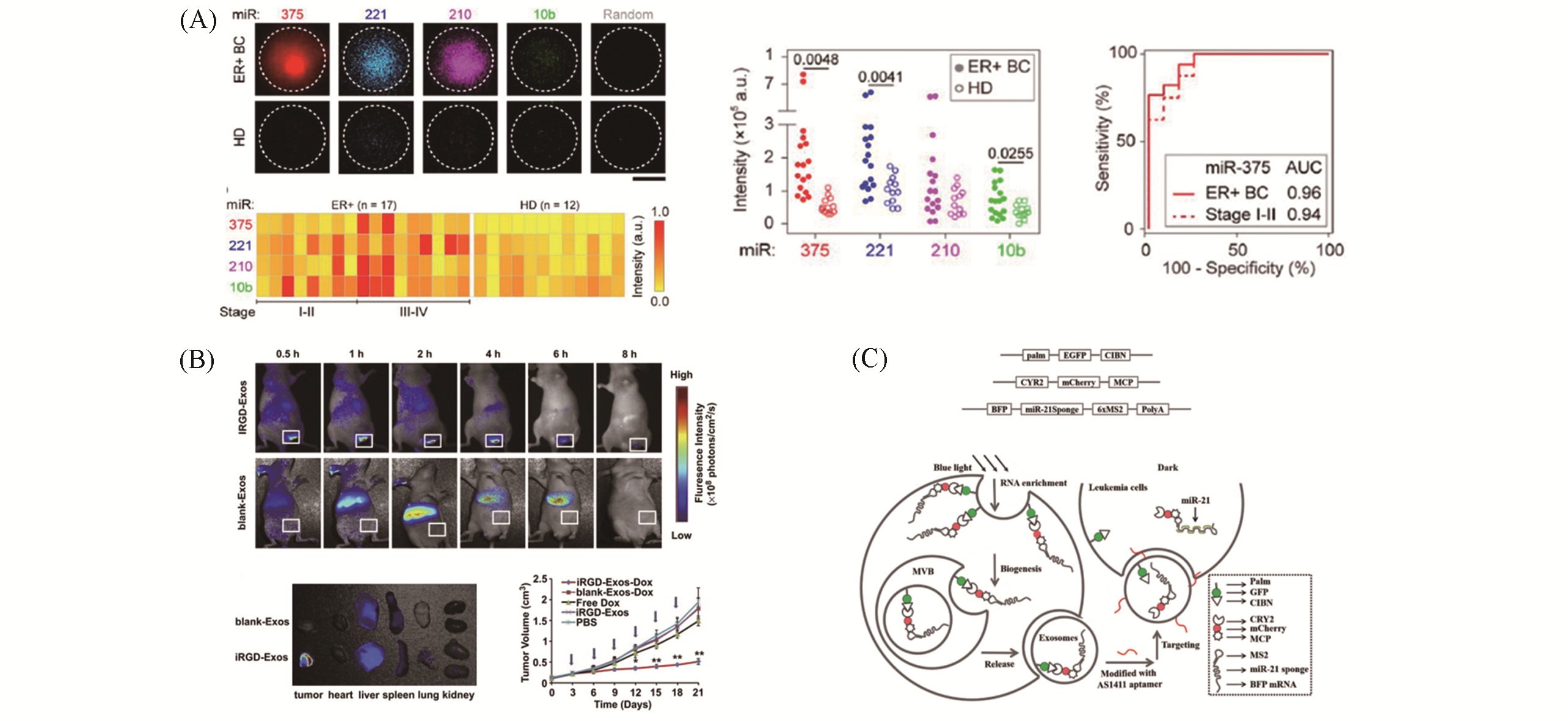
Fig.9 Clinical use of thermophoretic sensor for profiling exosomal miRNAs in breast cancer patients[108](A); antitumor activity of Exos?Dox[113](B); design of exosomes loading system[114](C)(A) Copyright 2020, American Chemical Society; (B) Copyright 2014, Elsevier; (C) Copyright 2019, Wiley.
| 1 | Théry C., Zitvogel L., Amigorena S., Nat. Rev. Immunol., 2002, 2, 569—579 |
| 2 | Bu H., He D., He X., Wang K., ChemBioChem, 2019, 20, 451—461 |
| 3 | Kalluri R., J. Clin. Invest., 2016, 126(4), 1208—1215 |
| 4 | Zhang Y. M., Wang F., Zhang H. X., Wang H. Y., Liu Y., Anal. Chem., 2019, 91(18), 12100—12107 |
| 5 | Raposo G., Stoorvogel W., J. Cell Biol., 2013, 200(4), 373—383 |
| 6 | Colombo M., Raposo G., Théry C., Annu. Rev. Cell Dev. Biol., 2014, 30(1), 255—289 |
| 7 | Niel G. V., Angelo G., Raposo G., Nat. Rev. Mol. Cell Biol., 2018, 19(4), 213—228 |
| 8 | McAndrews K. M., Kalluri R., Molecular Cancer, 2019, 18(1), 52—62 |
| 9 | Hessvik N. P., Llorente A., Cell. Mol. Life Sci., 2017, 75(3), 193—208 |
| 10 | Keerthikumar S., Chisanga D., Ariyaratne D., Al S. H., Anand S., Zhao K., Samuel M., Pathan M., Jois M., Chilamkurti N., J. Mol. Biol., 2016, 428, 688—692 |
| 11 | Pathan M., Fonseka P., Chitti S. V., Kang T., Sanwlani R., Deun J. V., Hendrix A., Mathivanan S., Nucleic Acids Res., 2018, 47(D1), D516—D519 |
| 12 | Lasda E., Parker R., PLoS One, 2016, 11(2), e0148407 |
| 13 | Ciardiello C., Cavallini L., Spinelli C., Yang J., Reis-Sobreiro M., Paola C., Minciacchi V. R., Vizio D. D., Int. J. Mol. Sci., 2016, 17(2), 175 |
| 14 | Gehrmann U., Naslund T. I., Hiltbrunner S., Larssen P., Gabrielsson S., Semin. Cancer Biol., 2014, 28, 58—67 |
| 15 | Kurywchak P., Tavormina J., Kalluri R., Genome Med., 2018, 10(1), 23—26 |
| 16 | Sullivan R., Saez F., Girouard J., Frenette G., Blood Cells Mol. Dis., 2005, 35(1), 1—10 |
| 17 | Guay C., Regazzi R., Diabetes Obes. Metab., 2017, 19, 137—146 |
| 18 | Budnik V., Ruiz⁃Cañada C., Wendler F., Nat. Rev. Neurosci., 2016, 17(3), 160—172 |
| 19 | Melo S. A., Sugimoto H., O’Connell J. T., Kato N., Villanueva A., Vidal A., Qiu L., Vitkin E., Perelman L. T., Melo C. A., Lucci A., Ivan C., Calin G. A., Kalluri R., Cancer Cell, 2014, 26(5), 707—721 |
| 20 | Vanderpol E., Boing A. N., Harrison P., Sturk A., Nieuwland R., Pharmacol. Rev., 2012, 64(3), 676—705 |
| 21 | Simpson R. J., Lim J. W., Moritz R. L., Mathivanan S., Expert Rev. Proteomic., 2009, 6(3), 267—283 |
| 22 | Salih M., Zietse R., Hoorn E. J., Am. J. Physiol. Renal. Physiol., 2014, 306(11), 1251—1259 |
| 23 | Revenfeld A. L., Baek R., Nielsen M. H., Stensballe A., Varming K., Malene J., Clin. Ther., 2014, 36(6), 830—846 |
| 24 | Andaloussi S. E., Mäger I., Breakefield X. O., Wood M. J. A., Nat. Rev. Drug Discov., 2013, 12(5), 347—357 |
| 25 | Contreras⁃Naranjo J. C., Wu H. J., Ugaz V. M., Lab Chip, 2017, 17(21), 3558—3577 |
| 26 | Kalluri R., LeBleu V. S., Science, 2020, 367(6478), eaau6977 |
| 27 | Ziaei P., Berkman C. E., Nortont M. G., ACS Appl. Nano Mater., 2018, 1(5), 2004—2020 |
| 28 | Cheng N., Du D., Wang X., Liu D., Xu W., Luo Y., Lin Y., Trends Biotechnol., 2019, 37(11), 1236—1254 |
| 29 | Filipe V., Hawe A., Jiskoot W., Pharm. Res., 2010, 27(5), 796—810 |
| 30 | Dragovic R. A., Gardiner C., Brooks A. S., Tannetta D. S., Ferguson D. J., Hole P., Carr B., Redman C. W., Harris A. L., Dobson P. J., Harrison P., Sargent I. L., Nanomedicine, 2011, 7(6), 780—788 |
| 31 | Dragovic R. A., Gardiner C., Brooks A. S., Tannetta D. S., Ferguson D. J. P., Hole P., Carr B., Redman C. W. G., Harris A. L., Dobson P. J., Harrison P., Sargent I. L., Nanomedicine, 2011, 7(6), 780—788 |
| 32 | Gardiner C., Ferreira Y. J., Dragovic R. A., Redman C. W. G., Sargent I. L., J. Extra. Vesicles, 2013, 2, 19671 |
| 33 | Shao H., Chung J., Balaj L., Charest A., Bigner D., Carter B. S., Hochberg F. H., Breakefield X. O., Weissleder R., Lee H., Nat. Med., 2012, 18(12), 1835—1840 |
| 34 | Wang H., Liu Y., Liu G., ACS Sens., 2018, 3(3), 624—631 |
| 35 | Veselinovic J., Almashtoub S., Seker E., Anal. Chem., 2019, 91(18), 11923—11931 |
| 36 | Wang S., Zhang L., Wan S., Cansiz S., Cui C., Liu Y., Cai R., Hong C., Teng I. T., Shi M., Wu Y., Dong Y., Tan W., ACS Nano, 2017, 11(4), 3943—3949 |
| 37 | Cao Y., Li L., Han B., Wang Y., Dai Y., Zhao J., Biosens. Bioelectron., 2019, 141(6), 111397 |
| 38 | Lu X., Wen Z., Li J., Biomaterials, 2006, 27(33), 5740—5747 |
| 39 | Zhang Q., Qiao Y., Hao F., Zhang L., Wu S., Li Y., Li J., Song X. M., Chemistry, 2010, 16(27), 8133—8139 |
| 40 | Yadav S., Boriachek K., Islam M. N., Lobb R., Mçller A., Hill M. M., Hossain M. S. A., Nguyen N. T.,Shiddiky M. J. A., ChemElectroChem, 2016, 4, 967—971 |
| 41 | Jeong S., Park J., Pathania D., Castro C. M., Weissleder R., Lee H., ACS Nano, 2016, 10(2), 1802—1809 |
| 42 | Chen L., Zeng X., Si P., Chen Y., Chi Y., Kim D. H., Chen G., Anal. Chem., 2014, 86(9), 4188—4195 |
| 43 | Moon P. G., You S., Lee J. E., Hwang D., Baek M. C., Mass Spectrom. Rev., 2011, 30, 1185—1202 |
| 44 | Jalalian S. H., Ramezani M., Jalalian S. A., Abnous K., Taghdisi S. M., Anal. Biochem., 2019, 571, 1—13 |
| 45 | Zhou Q., Rahimian A., Son K., Shin D. S., Patel T., Revzin A., Methods, 2016, 97, 88—93 |
| 46 | Doldan X., Fagundez P., Cayota A., Laíz J., Tosar J. P., Anal. Chem., 2016, 88, 10466—10473 |
| 47 | Yadav S., Boriachek K., Islam M. N., Lobb R., Mçller A., Hill M. M., Hossain M. S. A., Nguyen N. T., Shiddiky M. J. A., Chem. Electro. Chem., 2017, 4, 967—971 |
| 48 | Zhou Y. G., Mohamadi R. M., Poudineh M., Kermanshah L., Ahmed S., Safaei T. S., Stojcic J., Nam R. K., Sargent E. H., Kelley S. O., Small, 2016, 12(6), 727—732 |
| 49 | Zhang H. R., Wu M. S., Xu J. J., Chen H. Y., Anal. Chem., 2014, 86(8), 3834—3840 |
| 50 | Qi H., Zhang C., Anal. Chem., 2020, 92(1), 524—534 |
| 51 | Wang H., Yuan R., Chai Y., Cao Y., Gan X., Chen Y., Wang Y., Biosens. Bioelectron., 2013, 43, 63—68 |
| 52 | Feng Q. M., Shen Y. Z., Li M. X., Zhang Z. L., Chen H. Y., Anal. Chem., 2015, 88(1), 937—944 |
| 53 | Zhang H. X., Wang Z. H., Wang F., Zhang Y. M., Wang H. Y., Liu. Y., Anal. Chem., 2020, 92(7), 5546—5553 |
| 54 | Chen L., Zhang Y., Xia Q., Luo F., Guo L., Qiu B., Lin Z., Anal.Chim. Acta, 2020, 1122, 1—8 |
| 55 | Zhang C., Hu Q., Wu S., Chen F., Talanta, 2020, 217(121103), 1—6 |
| 56 | Zhang Z., Feng Q., Yang M., Tang Y., Sensors Actuat. B: Chem., 2020, 318, 128257 |
| 57 | El⁃Taboni F., Caseley E., Katsikogianni M., Swanson L., Swift T., Romero⁃González M. E., Langmuir 2020, 36(7), 1623—1632 |
| 58 | Zhang Y., Xiao J. Y., Zhu Y., Tian L. J., Wang W. K., Zhu T. T., Li W., Yu H. Q., Anal. Chem., 2020, 92(5), 3990—3997 |
| 59 | Zou Z., Liao X., Yang L., Huang Z., Yang H., Yan Q., Zhang Y., Qing Z., Zhang L., Feng F., Yang R., Anal. Chem., 2020, 92(5), 3555—3562 |
| 60 | Liu S. Y., Yan A. M., Guo W. Y. Z., Fang Y. Y., Dong Q. J., Li R. R., Ni S. N., Sun Y., Yang W. C., Yang G. F., ACS Nano, 2020, 14(4), 4244—4254 |
| 61 | Wang Y., Tang L., Li Z., Lin Y., Li J., Nat. Protoc., 2014, 9(8), 1944—1955 |
| 62 | Wang Y., Li Z., Weber T. J., Hu D., Lin C. T., Li J., Lin Y., Anal. Chem., 2013, 85(14), 6775—6782 |
| 63 | Zhang Q., Wang F., Zhang H., Zhang Y., Liu M., Liu Y., Anal. Chem., 2018, 90(21), 12737—12744 |
| 64 | Wang H., Chen H., Huang Z., Li T., Deng A., Kong J., Talanta, 2018, 184, 219—226 |
| 65 | Jin D., Yang F., Zhang Y., Liu L., Zhou Y., Wang F., Zhang G. J., Anal. Chem., 2018, 90(24), 14402—14411 |
| 66 | Wan S., Zhang L., Wang S., Liu Y., Wu C., Cheng Cui, Sun H., Shi M., Jiang Y., Li L., Qiu L., Tan W., J. Am. Chem. Soc., 2017, 139(15), 5289—5292 |
| 67 | He F., Wang J., Yin B. C., Ye B. C., Anal. Chem., 2018, 90(13), 8072—8079 |
| 68 | Wang L., Yang Y., Liu Y., Ning L., Xiang Y., Li G., Chem. Commun., 2019, 55(18), 2708—2711 |
| 69 | Li S., Zhao X., Yu X., Wan Y., Yin M., Zhang W., Cao B., Wang H., Anal. Chem., 2019, 91(22), 14737—14742 |
| 70 | Qiu N., Liu Y., Guo R., ACS Appl. Mater. Interfaces, 2020, 12(13), 15553—15561 |
| 71 | Xia Y., Liu M., Wang L., Yan A., He W., Chen M., Lan J., Xu J., Guan L., Chen J., Biosens. Bioelectron., 2017, 92, 8—15 |
| 72 | Jiang Y., Shi M., Liu Y., Wan S., Cui C., Zhang L., Tan W., Angew. Chem. Int. Ed. Engl., 2017, 56(39), 11916—11920 |
| 73 | Wang Y. M., Liu J. W., Adkins G. B., Shen W., Trinh M. P., Duan L. Y., Jiang J. H., Zhong W., Anal. Chem., 2017, 89(22), 12327—12333 |
| 74 | Ferreira N., Marques A., Aguas H., Bandarenka H., Martins R., Bodo C., Costasilva B., Fortunato E., ACS Sens., 2019, 4(8), 2073—2083 |
| 75 | Lee J. U., Kim W. H., Lee H. S., Park K. H., Sim S. J., Small, 2019, 15(17), 1804968 |
| 76 | Pang Y., Wang C., Lu L., Wang C., Sun Z., Xiao R., Biosens. Bioelectron., 2019, 130, 204—213 |
| 77 | Li T. D., Zhang R., Chen H., Huang Z. P., Ye X., Wang H., Deng A. M., Kong J. L., Chem. Sci., 2018, 9(24), 5372—5382 |
| 78 | Kwizera E. A., O’Connor R., Vinduska V., Williams M., Butch E. R., Snyder S. E., Chen X., Huang X., Theranostics, 2018, 8(10), 2722—2738 |
| 79 | Tian Y. F., Ning C. F., He F., Yin B. C., Ye B. C., Analyst, 2018, 143(20), 4915—4922 |
| 80 | Zong S., Wang L., Chen C., Lu J., Zhu D., Zhang Y., Wang Z., Cui Y., Anal. Methods, 2016, 8, 5001—5008 |
| 81 | Wang Z., Zong S., Wang Y., Li N., Li L., Lu J., Wang Z., Chen B., Cui Y., Nanoscale, 2018, 10(19), 9053—9062 |
| 82 | Wang Q., Zou L., Yang X., Liu X., Nie W., Zheng Y., Cheng Q., Wang K., Biosens. Bioelectron., 2019, 135, 129—136 |
| 83 | Sina A. A. I., Vaidyanathan R., Wuethrich A., Carrascosa L. G., Trau M., Anal. Bioanal. Chem., 2019, 411(7), 1311—1318 |
| 84 | Liu C., Zeng X., An Z., Yang Y., Eisenbaum M., Gu X., Jornet J. M., Dy G. K., Reid M. E., Gan Q., Wu Y., ACS Sens., 2018, 3(8), 1471—1479 |
| 85 | Di Noto G., Bugatti A., Zendrini A., Mazzoldi E. L., Montanelli A., Caimi L., Rusnati M., Ricotta D., Bergese P., Biosens. Bioelectron., 2016, 77, 518—524 |
| 86 | Zhu L., Wang K., Cui J., Liu H., Bu X., Ma H., Wang W., Gong H., Lausted C., Hood L., Yang G., Hu Z., Anal. Chem., 2014, 86(17), 8857—8864 |
| 87 | Picciolini S., Gualerzi A., Vanna R., Sguassero A., Gramatica F., Bedoni M., Masserini M., Morasso C., Anal. Chem., 2018, 90(15), 8873—8880 |
| 88 | Thakur A., Qiu G., Ng S. P., Guan J., Yue J., Lee Y., Wu C. M. L., Biosens. Bioelectron., 2017, 94, 400—407 |
| 89 | Qiu G., Thakur A., Xu C., Ng S. P., Lee Y., Wu C. M. L., Adv. Funct. Mater. , 2019, 29, 1806761 |
| 90 | Ayalamar S., Perezgonzalez V. H., Matagomez M. A., Gallovillanueva R. C., Gonzalezvaldez J., Anal. Chem., 2019, 91(23), 14975—14982 |
| 91 | Kang Y., Purcell E., Palaciosrolston C., Lo T., Ramnath N., Jolly S., Nagrath S., Small, 2019, 15(47), 1903600 |
| 92 | Liu C., Guo J., Tian F., Yang N., Yan F., Ding Y., Wei J., Hu G., Nie G., Sun J., ACS Nano, 2017, 11(7), 6968—6976 |
| 93 | Xu H., Liao C., Zuo P., Liu Z., Ye B. C., Anal. Chem., 2018, 90(22), 13451—13458 |
| 94 | Taller D., Richards K., Slouka Z., Senapati S., Hill R., Go D. B., Chang H. C., Lab on a Chip, 2015, 15(7), 1656—1666 |
| 95 | Shao H., Chung J., Lee K., Balaj L., Min C., Carter B. S., Hochberg F. H., Breakefield X. O., Lee H., Weissleder R., Nat. Commun., 2015, 6, 6999 [96] Théry C., Nature, 2015, 523(7559), 161—162 |
| 97 | Pucci F., Garris C., Lai C. P., Newton A., CPfirschke, Engblom C., Alvarez D., Sprachman M., Evavold C., Magnuson A., Andrian U. H. v., Glatz K., Breakefield X. O., RMempel T., Weissleder R., Pittet M. J., Science, 2016, 352(6282), 242—246 |
| 98 | Shao H., Chung J., Issadore D., Biosci Rep., 2015, 36(1), e00292 |
| 99 | Fitts C. A., Ji N., Li Y., Tan C., Adv. Healthc Mater., 2019, 8(6), e1801268 |
| 100 | Barile L., Vassalli G., Pharmacol Ther., 2017, 174, 63—78 |
| 101 | Ferguson S. W., Nguyen J., J. Control Release, 2016, 228, 179—190 |
| 102 | Jansen F., Li Q., Adv. Exp. Med. Biol., 2017, 998, 61—70 |
| 103 | Kanninen K. M., Bister N., Koistinaho J., Malm T., Biochim. Biophys. Acta, 2016, 3, 403—410 |
| 104 | Masyuk A. I., Masyuk T. V., Larusso N. F., J. Hepatol., 2013, 59(3), 621—625 |
| 105 | Elmageed Z. Y. A., Yang Y., Thomas R., Ranjan M., Mondal D., Moroz K., Fang Z., Rezk B. M., Moparty K., Sikka S. C., Sartor O., Abdel⁃Mageed A. B., Stem Cells, 2014, 32(4), 983—997 |
| 106 | Le M. T., Hamar P., Guo C., Basar E., Perdigão⁃Henriques R., Balaj L., Lieberman J., J. Clin. Invest., 2014, 124(12), 5109—5128 |
| 107 | Melo S. A., Luecke L. B., Kahlert C., Fernandez A. F., Gammon S. T., Kaye J., LeBleu V. S., Mittendorf E. A., Weitz J., Rahbari N., Reissfelder C., Pilarsky C., Fraga M. F., Piwnica⁃Worms D., Kalluri R., Nature, 2015, 523(7559), 177—182 |
| 108 | Zhao J., Liu C., Li Y., Ma Y., Deng J., Li L., Sun J., J. Am. Chem. Soc., 2020, 142(11), 4996—5001 |
| 109 | Keerthikumar S., Chisanga D., Ariyaratne D., Saffar H. A., Anand S., Zhao K., Samuel M., Pathan M., Jois M., Chilamkurti N., Gangoda L., Mathivanan S., J. Mol. Biol., 2016, 428(4), 688—692 |
| 110 | Kishore R., Garikipati V. N. S., Gumpert A., J. Cardiovasc Transl. Res., 2016, 9(3), 169—175 |
| 111 | Ju Z., J. Ma, Wang C., Yu J., Qiao Y., Hei F., Inflammation, 2017, 40(2), 486—496 |
| 112 | Viaud S., Théry C., Ploix S., Tursz T., Lapierre V., Lantz O., Zitvogel L., Chaput N., Cancer Res., 2010, 70(4), 1281—1285 |
| 113 | Tian Y., Li S., Song J., Ji T., Zhu M., Anderson G. J., Wei J., Nie G., Biomaterials, 2014, 35(7), 2383—2390 |
| 114 | Huang L., Gu N., Zhang X. E., Wang D. B., Adv. Funct. Mater., 2019, 29, 1807189 |
| 115 | Poggio M., Hu T., Pai C. C., Chu B., Belair C. D., Chang A., Montabana E., Lang U. E., Fu Q., Fong L., Blelloch R., Cell, 2019, 177(2), 414—427 |
| [1] | 王君旸, 刘争, 张茜, 孙春燕, 李红霞. DNA银纳米簇在功能核酸荧光生物传感器中的应用[J]. 高等学校化学学报, 2022, 43(6): 20220010. |
| [2] | 徐梦祎, 黄雪雯, 李小杰, 魏玮, 刘晓亚. “串珠状”复合纳米组装体修饰丝网印刷电极构建的生物传感器[J]. 高等学校化学学报, 2021, 42(6): 1768. |
| [3] | 黄玲, 庄梓健, 李翔, 石沐玲, 刘高强. 基于核酸适体的外泌体分子识别研究进展[J]. 高等学校化学学报, 2021, 42(11): 3493. |
| [4] | 王博东, 潘美辰, 卓颖. 二氧化硅纳米颗粒表面原位还原银纳米簇电化学发光传感界面的构建与分子识别[J]. 高等学校化学学报, 2021, 42(11): 3519. |
| [5] | 张嘉懿, 丁臻尧, 王丹丹, 陈礼平, 封心建. 基于多孔金结构的三相界面酶电极的制备及高效电化学酶传感性能[J]. 高等学校化学学报, 2021, 42(10): 3167. |
| [6] | 白翠婷, 岳仁叶, 罗列高, 马楠. 基于双色荧光传感器的癌细胞成像及microRNA定量检测[J]. 高等学校化学学报, 2020, 41(6): 1252. |
| [7] | 郑姗, 刘洋, 陈飘飘, 邢怡晨, 黄朝表. 基于PbS QDs/TiO2 NPs构建新型谷胱甘肽光电化学传感器[J]. 高等学校化学学报, 2019, 40(9): 1866. |
| [8] | 周羽婷, 汤玉娇, 邵爽, 戴诗岩, 程圭芳, 何品刚, 方禹之. 构象转换型传感器对汞、 铅、 锶离子的同时检测[J]. 高等学校化学学报, 2019, 40(8): 1621. |
| [9] | 王春燕,蒋晓青,周泊. 基于Cu-TPA的电化学生物传感器对黄曲霉毒素B1的检测[J]. 高等学校化学学报, 2019, 40(11): 2301. |
| [10] | 黄海平, 岳亚锋, 徐亮, 吕连连, 胡咏梅. 基于Dy2(MoO4)3-AuNPs复合纳米材料的葡萄糖生物传感器[J]. 高等学校化学学报, 2017, 38(4): 554. |
| [11] | 刘仁植, 李晓严. MoS2中空纳米球的制备及在超灵敏microRNA电化学生物传感器中的应用[J]. 高等学校化学学报, 2017, 38(3): 383. |
| [12] | 徐亮, 林有芹, 陈旭, 路艳罗, 杨文胜. 基于铂纳米颗粒电沉积镁铝水滑石修饰电极的电化学葡萄糖生物传感器[J]. 高等学校化学学报, 2016, 37(3): 442. |
| [13] | 景蔚萱, 周帆, 陈路加, 齐含, 蒋庄德, 王兵, 牛玲玲. 基于ZnO纳米线的螺旋线形跨尺度葡萄糖传感器[J]. 高等学校化学学报, 2014, 35(3): 493. |
| [14] | 屈建莹, 康世平, 娄童芳, 杜学萍. 基于聚乙烯醇离子液体负载HRP修饰石墨烯/纳米金复合膜的过氧化氢生物传感器[J]. 高等学校化学学报, 2013, 34(9): 2097. |
| [15] | 王青, 刘卫, 羊小海, 王柯敏, 刘沛, 何磊良. 纳米金颗粒增强信号的电化学生物传感器用于谷胱甘肽和半胱氨酸的检测[J]. 高等学校化学学报, 2013, 34(8): 1845. |
| 阅读次数 | ||||||
|
全文 |
|
|||||
|
摘要 |
|
|||||